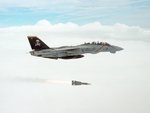evangilder
"Shooter"
News-Register.comBy LAURENT L.N. BONCZIJK
Of The News Register
The Evergreen Aviation Museum was poised today to take the first step toward addition of a choice piece to its collection - an F-14D Super Tomcat, the fighter plane Tom Cruise flew in the hit film "Top Gun."
But the flareup of violence between the Israeli army and Hezbollah and Hamas militias in Lebanon and Gaza led to a change in plans. The Navy, which had been planning to replace the U.S.S. Theodore Roosevelt's F-14 Tomcats with newer, more multi-dimensional F-18 Hornets, has decided to instead dispatch the carrier to the Middle East with its current squadron of F-14s - including the one promised to the museum.
According to Colin Powers, Evergreen's director of air restoration, the museum is still in line for the plane, which will be flown into Portland, dismantled there and trucked down to McMinnville for reassembly. But not until its new unscheduled tour ends, and no one yet knows when that will be.
The Navy had originally planned to fly the plane directly into town. It would have been the largest and most powerful jet fighter ever to touch down at the McMinnville Airport.
However, officers eventually concluded that the airport lacked sufficient runway length, and that setting up the cable-hooking mechanism used for F-14 carrier landings wasn't feasible. They decided they would have to fly it into Portland instead.
The plane had been scheduled to make the cross-country flight from Virginia's Naval Air Station Oceana to Oregon's Portland International Airport today, then undergo dismantling in preparation for shipment on to McMinnville by truck - a process expected to take about two weeks.
A four-member crew from the Titan Corporation had already been dispatched from Norfolk, Va., with all of the necessary equipment. But that mission will have to be rescheduled, in light of the developments.
When the plane joins the collection, it will be on permanent loan from the National Museum of Naval Aviation. It will join the HK-1 Flying Boat seaplane, SR-71 Blackbird spy plane and Titan II missile among top museum showpieces.
Last used in the bombing of targets in Iraq in October, the plane destined for the museum runs 62 feet in length, 16 feet in height and 38 to 64 feet in width, depending on whether it has its wings fully extended or in swept-back position.
Crews will have to remove its wings, horizontal stabilizer and vertical fins for manageable truck transport and its engines, armaments and ejection seat mechanism for safe museum display. The disassembly in Portland is expected to take about two weeks and the partially reassembly for display is expected to take a like period once it reaches McMinnville.
The plane is part of fighter squadron VF-31, whose insignia features the cartoon character Felix the Cat. The squadron has long been assigned to the Roosevelt, which had been supporting U.S. military operations in Iraq prior to being called home for re-outfitting with F-18 hornets.
The F-14 was designed to provide air superiority over Soviet fighters in dogfights staged in defense of U.S. aircraft carriers. Thus, it did not transition well to other roles, such as the precision bombing called for in Iraq.
VF-31 is one of only two squadrons in the U.S. Navy still flying Tomcats. The Navy, which began taking delivery on them in the early 1970s, has been steadily swapping them out of its carrier-based squadrons in favor of the more versatile Hornets.


